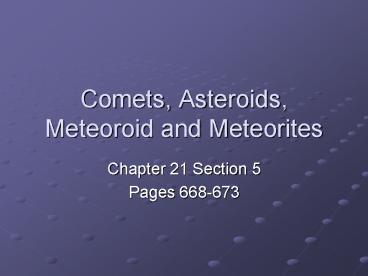Comets, Asteroids, Meteoroid and Meteorites - PowerPoint PPT Presentation
1 / 20
Title:
Comets, Asteroids, Meteoroid and Meteorites
Description:
Comets, Asteroids, Meteoroid and Meteorites Chapter 21 Section 5 Pages 668-673 Comets A comet is a small body of ice, rock and cosmic dust loosely packed together. – PowerPoint PPT presentation
Number of Views:883
Avg rating:3.0/5.0
Title: Comets, Asteroids, Meteoroid and Meteorites
1
Comets, Asteroids, Meteoroid and Meteorites
- Chapter 21 Section 5
- Pages 668-673
2
Comets
- A comet is a small body of ice, rock and cosmic
dust loosely packed together. - Scientists refer to them as dirty snowballs.
3
(No Transcript)
4
Comets Orbit
- Comets orbit the Sun in highly elliptical orbits.
- Their velocity increases greatly when they are
near the Sun and slows down at the far reaches of
the orbit. - Since the comet is light only when it is near the
Sun (and is it vaporizing), comets are dark
(virtually invisible) throughout most of their
orbit. - The solar wind pushes the tail away from the Sun.
5
Parts of a Comet
- When they are near the Sun and active, comets
have several distinct parts - Nucleus relatively solid and stable, mostly ice
and gas with a small amount of dust and other
solids - Coma dense cloud of water, carbon dioxide and
other neutral gases - Hydrogen cloud huge (millions of km in diameter)
but very sparse envelope of neutral hydrogen - Dust tail up to 10 million km long composed of
smoke-sized dust particles driven off the nucleus
by escaping gases this is the most prominent
part of a comet to the unaided eye - Ion tail as much as several hundred million km
long composed of plasma and laced with rays and
streamers caused by interactions with the solar
wind.
6
(No Transcript)
7
The comet's tail gets bigger as it gets closer to
the sun and then decreases as it moves away from
the sun.
8
Comets Facts
- A comets ion tail always points away from the
sun. - Solar winds blow the ion tail away from the sun.
- The dust tail follows the comets orbit and do
not always point away from the sun. - Scientists believe that comets come from the Oort
Cloud, a region that surrounds the solar system. - Comets can also come from the Kuiper Belt which
exists outside of Neptunes orbit.
9
Shoemaker-Levy Comet
- On 1994 July 16-22, over twenty fragments of
comet Shoemaker-Levy 9 collided with the planet
Jupiter. - The comet, discovered the previous year by
astronomers Carolyn and Eugene Shoemaker and
David Levy, was observed by astronomers at
hundreds of observatories around the world as it
crashed into Jupiter's southern hemisphere.
10
(No Transcript)
11
Video Link to NEOs (Near Earth Objects)
- http//neo.jpl.nasa.gov/neo/
12
Asteroids
- Asteroids are small rocky bodies that revolve
around the sun. - They range in size from a few meters to more than
900 kilometers in diameter. - Asteroids have irregular shapes, but some are
spherical, or round. - Most asteroids orbit the sun in asteroid belt.
- The asteroid belt orbits between Mars and
Jupiter. - Asteroids are thought to be left over from the
formation of the solar system.
13
(No Transcript)
14
Meteoroids, Meteors and Meteorites
- Meteoroids are small rocky bodies that travel
through space. - A meteor is a bright streak that results from a
meteoroid burns up in Earths atmosphere, what we
call shooting stars. - A meteorite is a meteoroid that reaches the
Earths surface without burning up.
15
Three Types of Meteorites
- Stony- Rocky material
- Metallic- Iron and Nickel
- Stony Metallic- Rocky material, iron and nickel
16
Stony Meteorites
- Rocky material
17
Metallic Meteorite
- iron and nickel
18
Stony-Iron Meteorite
- rocky material, iron and nickel
19
Meteorite Crater-Winslow, Arizona
- Winslow, Arizona
This crater was formed approximately 50,000 years
ago when an iron mass, estimated to be about 80
feet in diameter and weighing over 60,000 tons
entered the Earth's atmosphere over the American
Southwest. The resulting formation is about 4,000
feet (1,200 meters) wide and 570 feet (175
meters) deep.
20
A fragment of the meteorite that created
Meteorite Crater.
Metallic Meteorite































